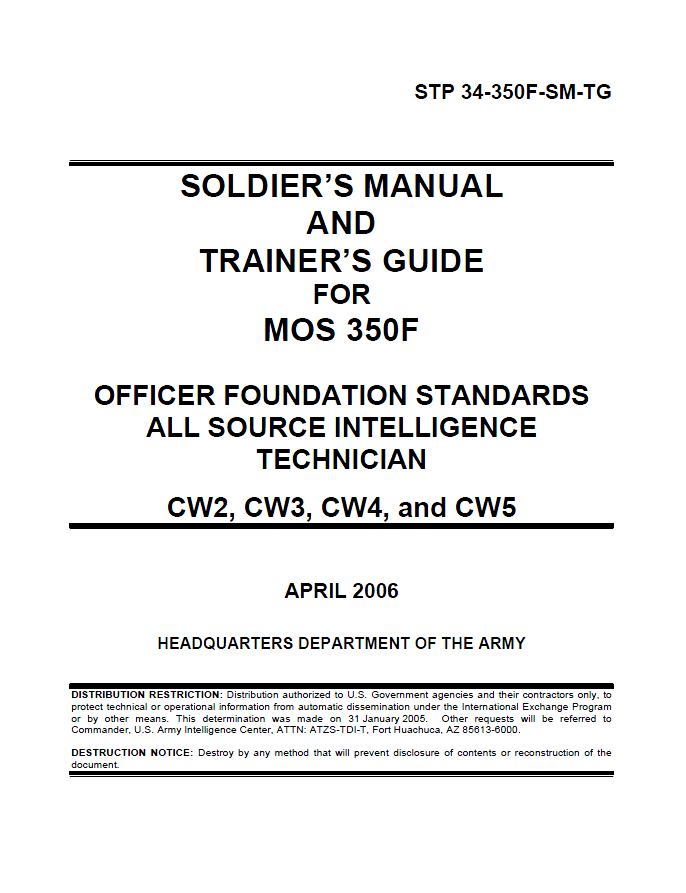OFFICER FOUNDATION STANDARDS ALL SOURCE INTELLIGENCE TECHNICIAN
- 52 pages
- Distribution authorized to U.S. Government agencies and their contractors only, to protect technical or operational information from automatic dissemination under the International Exchange Program or by other means.
- April 2006
This publication is for officers holding military occupational specialty (MOS) 350F and their trainers or first-line supervisors. It contains standardized training objectives, in the form of task summaries, which support unit missions during wartime. Officers holding MOS 350F should be issued or have access to this publication. It should be available in the officer’s work area, unit learning center, and unit libraries. Trainers and first-line supervisors should actively plan for officers to have access to this publication.
…
DIRECT INTELLIGENCE SUPPORT TO THE TARGETING PROCESS
301-50B-1005Condition: Given the current situation, threat holdings, mission statement, mission requirements, operations order (OPORD), commander’s priority intelligence requirements/intelligence requirements (PIR/IR), commander’s intent, FM 3-0, FM 34-3, FM 6-20, FM 6-20-10, FM 5-0, and unit standing operating procedures (SOPs).
Standard: Directed the intelligence support to the targeting process in accordance with commander’s intent, mission requirements, FM 3-0, FM 34-3, FM 6-20, FM 6-20-10, FM 5-0, ST 100-3 and unit SOP.
Performance Steps
1. Obtain the commander’s concept of operations, intent, and scheme of maneuver within the area of operations (AO).
2. Direct the development of key targeting products, including target intelligence packets (TIPs) and battle damage assessment (BDA) products, high-value target list (HVTL), highpayoff target list (HPTL), attack guidance matrix (AGM), and target selection standards (TSS).
3. Determine threat reactions to the loss of each identified high-value target (HVT).
4. Coordinate with other staff members to identify information needed to fulfill identification and engagement parameters.
5. Submit confirmed or suspected targets, along with their recommended priorities for exploitation, to fire support element (FSE) personnel and operations in a timely manner.
6. Direct the TIP development for deep or specific targets based on operational requirements.
7. Direct the evaluation of targets neutralized battle damage assessment (BDA) and provide additional recommendations for suspected or confirmed targets for exploitation.
Evaluation Preparation: Provide the officer with the materials listed in the condition statement. Tell the solder to provide intelligence support to the targeting process in accordance with commander’s intent and mission requirements.
…
CONDUCT PREDICTIVE ANALYSIS
301-50B-1006Condition: Given a situation, or an operation plan (OPLAN), or an operation order (OPORD), threat holdings, reporting from multiple sources, analytical tools, FM 2-0, FM 34-3, FM 34-8-2, ST 100-3, and unit standing operating procedures (SOPs).
Standard: Applied principles of predictive analysis in order to present updated intelligence products in accordance with the level of detail required by the commander.
Performance Steps
Conducted timely, accurate, and predictive all source analysis is what makes 350Fs critical members of the commander’s staff. Predictive analysis is what makes quality intelligence preparation of the battlefield (IPB) products, supports successful staff military decision-making process (MDMP), collection management, and target development. Any intelligence Soldier can read reports and present their information. However, a true intelligence analyst details what the reports mean and how the commander should act to counter the reported threat. Predicting future actions is what enables the 350F to advise the commander on recommended friendly actions against the threat.
1. Review current intelligence holdings, integrating information and intelligence reporting from multiple sources.
2. Compare current intelligence holdings with threat doctrine; tactics, techniques, and procedures (TTPs), and previously produced course of actions (COAs). Know enemy TTP’s capabilities, trends, and intentions.
3. Analyze and interpret threat holdings, identifying indicators of threat COAs, intentions, and objectives.
4. Develop a predictive assessment on threat activity for the next 24-/48-/72-hours to 30 to 180 days, depending on mission requirements.
5. Present the updated threat assessment to the commander and staff.
Evaluation Preparation: Ensure that the materials in the condition statement are available. Tell the officer to develop a predictive assessment on threat activity for the next 48-hours.

